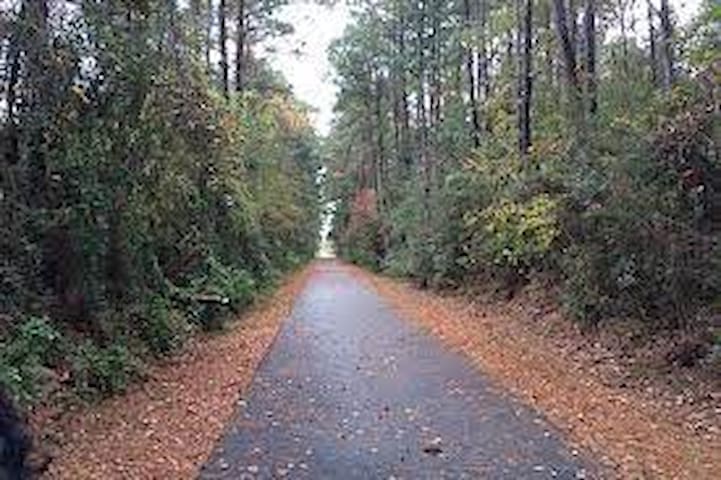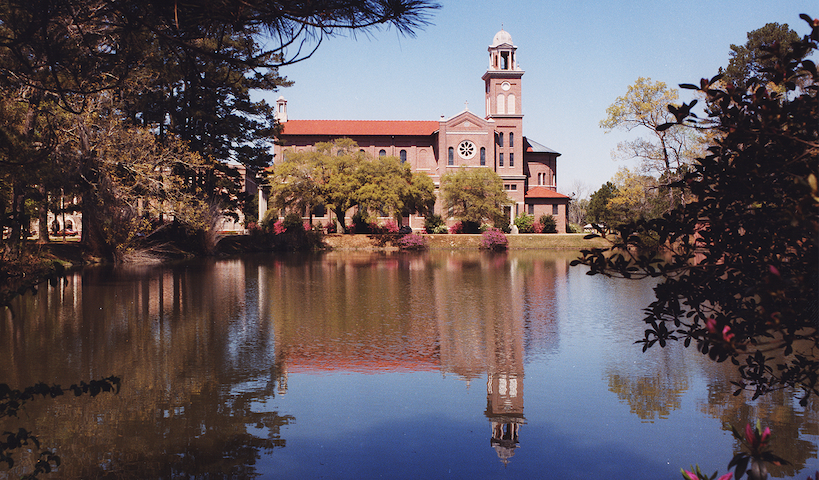Sightseeing
The Tammany Trace is a rail trail in St. Tammany Parish, Louisiana, occupying a former Illinois Central Railroad corridor.
It has been developed into a 31-mile (50 km) asphalt trail for hiking, cycling, and wheelchair use. Some parts of the Trace include a separate equestrian pathway suitable for horse riding.
It connects Covington, Abita Springs, Mandeville, Lacombe, and Slidell, running along the northern shore of Lake Pontchartrain. The trail was damaged by Hurricane Katrina in 2005, but was reopened by early 2007. The Trace is easily accessible from Fontainebleau State Park.
Tammany Trace Bike Trail
Tammany Trace Bike TrailThe Tammany Trace is a rail trail in St. Tammany Parish, Louisiana, occupying a former Illinois Central Railroad corridor.
It has been developed into a 31-mile (50 km) asphalt trail for hiking, cycling, and wheelchair use. Some parts of the Trace include a separate equestrian pathway suitable for horse riding.
It connects Covington, Abita Springs, Mandeville, Lacombe, and Slidell, running along the northern shore of Lake Pontchartrain. The trail was damaged by Hurricane Katrina in 2005, but was reopened by early 2007. The Trace is easily accessible from Fontainebleau State Park.
St. Joseph Abbey was founded in 1889 by a group of monks from St. Meinrad Archabbey in Indiana. These monks from Indiana traveled to Louisiana at the invitation of the Most Reverend Francis Janssens to form a college seminary for training local vocations. Up until this time the diocese of New Orleans was being staffed by foreign pastors and was in desperate need for native born priests. St. Benedict, Louisiana, was not the first choice for the establishment of a monastery and seminary college. The traveling monks from St. Meinrad Abbey originally chose a spot of land consisting of seventeen hundred acres located in Ponchatoula, Louisiana, near Baton Rouge. The monks arrived to this location in 1889 and founded a monastery and seminary. They named the original establishment Gessen. After just a few years at this location the monks encountered many hardships including unworkable land, and illness caused by mosquitoes. In 1902, the monks decided to relocate the monastery and seminary to a former rice plantation at St. Benedict, Louisiana near Covington north of New Orleans. The monks changed the name of the monastery and seminary from Gessen to St. Joseph. The present location of St. Joseph Abbey occupies a total of 1,500 acres of piney wooded land.
Saint Joseph Abbey
Saint Joseph AbbeySt. Joseph Abbey was founded in 1889 by a group of monks from St. Meinrad Archabbey in Indiana. These monks from Indiana traveled to Louisiana at the invitation of the Most Reverend Francis Janssens to form a college seminary for training local vocations. Up until this time the diocese of New Orleans was being staffed by foreign pastors and was in desperate need for native born priests. St. Benedict, Louisiana, was not the first choice for the establishment of a monastery and seminary college. The traveling monks from St. Meinrad Abbey originally chose a spot of land consisting of seventeen hundred acres located in Ponchatoula, Louisiana, near Baton Rouge. The monks arrived to this location in 1889 and founded a monastery and seminary. They named the original establishment Gessen. After just a few years at this location the monks encountered many hardships including unworkable land, and illness caused by mosquitoes. In 1902, the monks decided to relocate the monastery and seminary to a former rice plantation at St. Benedict, Louisiana near Covington north of New Orleans. The monks changed the name of the monastery and seminary from Gessen to St. Joseph. The present location of St. Joseph Abbey occupies a total of 1,500 acres of piney wooded land.
The Mandeville Lakefront, 1834. This passive park, about one mile in length, was set apart by protective covenant by the town’s founder, Jean Bernard Xavier Phillippe de Marigny de Mandeville (1785-1868). On Lake Pontchartrain (so named in 1699 by Pierre LeMoyne, Sieur d’Iberville for the French Minister of Marine, Louis Phelypaux, Count de Pontchartrain), this is Mandeville’s heart and soul. Once there were numerous private and public wharves, steamer traffic, an electric rail car, and bath houses. All that remains of the golden age (1870-1930) is the gazebo, which has been rebuilt many times (2100 block) and the fountain, once fed by a natural spring (2200 block).
From a letter by Pere Pierre Alphonse Chocarne, May 17, 1867 – "to Mandeville, which nestles near the border of the lake with neighboring villas and charming summer residences stretching along the shore…..Then came the fury of a tropical storm, succeeded by the magnificent sunset in the midst of clouds of gold and fire seen beyond the giant trees.”
It is a Mandeville we all recognize today even though the letter was written over 100 years ago. And the lakefront’s beautiful sunsets, unpredictable tropical weather and massive oaks remain the heart and soul.
11 íbúar mæla með
Mandeville Lakefront
2623 Lakeshore DrThe Mandeville Lakefront, 1834. This passive park, about one mile in length, was set apart by protective covenant by the town’s founder, Jean Bernard Xavier Phillippe de Marigny de Mandeville (1785-1868). On Lake Pontchartrain (so named in 1699 by Pierre LeMoyne, Sieur d’Iberville for the French Minister of Marine, Louis Phelypaux, Count de Pontchartrain), this is Mandeville’s heart and soul. Once there were numerous private and public wharves, steamer traffic, an electric rail car, and bath houses. All that remains of the golden age (1870-1930) is the gazebo, which has been rebuilt many times (2100 block) and the fountain, once fed by a natural spring (2200 block).
From a letter by Pere Pierre Alphonse Chocarne, May 17, 1867 – "to Mandeville, which nestles near the border of the lake with neighboring villas and charming summer residences stretching along the shore…..Then came the fury of a tropical storm, succeeded by the magnificent sunset in the midst of clouds of gold and fire seen beyond the giant trees.”
It is a Mandeville we all recognize today even though the letter was written over 100 years ago. And the lakefront’s beautiful sunsets, unpredictable tropical weather and massive oaks remain the heart and soul.
Food scene
The Abita Brewing Company is a brewery in Covington, Louisiana, United States, 43 miles (69 km) north of New Orleans. Abita was founded by Jim Patton and Rush Cumming in 1986, in downtown Abita Springs, Louisiana. The original location in downtown Abita Springs is now the Abita Brew Pub. The company brews its beer with water from artesian wells. In August 2005, Stuff Magazine called Abita's Turbodog Ale the best beer made in America. Abita Bock was listed among the Top 10 Spring Beers by Fox News in 2012. Abita Bock is the brewery's first seasonal brew and is available January - March.
33 íbúar mæla með
Abita Brewing Company
21084 LA-36The Abita Brewing Company is a brewery in Covington, Louisiana, United States, 43 miles (69 km) north of New Orleans. Abita was founded by Jim Patton and Rush Cumming in 1986, in downtown Abita Springs, Louisiana. The original location in downtown Abita Springs is now the Abita Brew Pub. The company brews its beer with water from artesian wells. In August 2005, Stuff Magazine called Abita's Turbodog Ale the best beer made in America. Abita Bock was listed among the Top 10 Spring Beers by Fox News in 2012. Abita Bock is the brewery's first seasonal brew and is available January - March.


